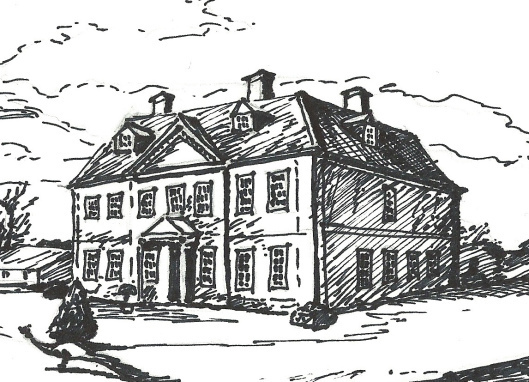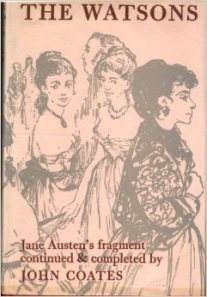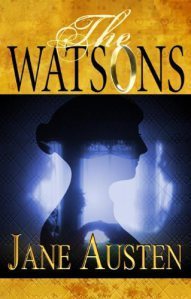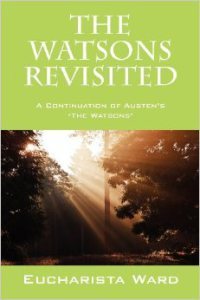Sarah Emsley's Blog, page 35
April 9, 2014
Your Invitation to Mansfield Park
 You’re invited to a conversation about Jane Austen’s Mansfield Park!
You’re invited to a conversation about Jane Austen’s Mansfield Park!
When: from May 9 to December 31, 2014
Where: right here at sarahemsley.com
I really hope you’ll join us in celebrating 200 years of Austen’s masterpiece. More than forty wonderful people are writing guest posts about Mansfield Park for my blog this year, and I hope you’ll all participate in the discussion in the comments. With exactly one month to go before the 200th anniversary of the novel’s publication, the countdown is on!
The party begins on Friday, May 9th, with Lyn Bennett’s thoughts on the first paragraph, followed in the next few weeks by Judith Thompson on Mrs. Norris and adoption, Jennie Duke on Fanny Price at age ten (“though there might not be much in her first appearance to captivate, there was, at least, nothing to disgust her relations”), Cheryl Kinney on Tom Bertram’s assessment of Dr. Grant’s health (“he was a short–necked, apoplectic sort of fellow, and, plied well with good things, would soon pop off”), and Katie Davis on Mrs. Grant’s promise to Mary and Henry Crawford that “Mansfield shall cure you both.” Many other excellent guest posts will follow throughout the summer and fall. Plus, one week before the series begins, Deborah Barnum of Jane Austen in Vermont is going to tell us all about the publication history of Mansfield Park. 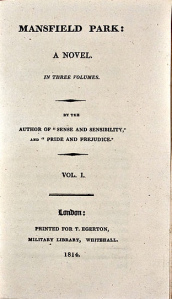
Please share this invitation with anyone who might want to participate in the conversations about, and celebration of, this brilliant novel. For the full list of contributors to the series, visit my new page “An Invitation to Mansfield Park,” which also includes links to several other blog posts and articles on the novel. Please let me know if you have suggestions for resources to add to this list. What have you been reading recently about Mansfield Park?
You can also visit my Pinterest board for Mansfield Park, and I’d love to hear from you about book covers and other MP-related images to add to the collection.
Many thanks to Laurel Ann Nattress of Austenprose.com, who gave me the elegant title “An Invitation to Mansfield Park” (thereby saving me from becoming Miss Bates), and thank you to everyone who contributed suggestions about the title. Thank you to Maggie Arnold for the lovely sketches of Mansfield Park and of Fanny Price reading. Thank you to everyone who’s writing for the series, and, of course, a huge thank you to all of you who are reading with us! Let me know if you’re coming to this party.


April 2, 2014
Anne of Green Gables and the Old Burying Ground, Halifax
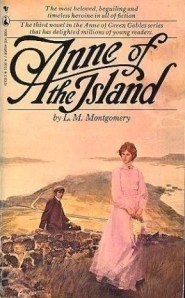 When Anne Shirley first arrives in Kingsport (Halifax), in L.M. Montgomery’s Anne of the Island, she’s told that her room looks out on “Old St. John’s Graveyard,” across the street from her boarding house. She says the view sounds “gruesome,” but her friend Priscilla makes the case for the graveyard as a romantic spot. Much has changed in Halifax in the century since L.M. Montgomery was a student at Dalhousie, but the Old Burying Ground has changed very little (thanks to the efforts of the Old Burying Ground Foundation). Here’s Priscilla’s description, at the end of Chapter Three:
When Anne Shirley first arrives in Kingsport (Halifax), in L.M. Montgomery’s Anne of the Island, she’s told that her room looks out on “Old St. John’s Graveyard,” across the street from her boarding house. She says the view sounds “gruesome,” but her friend Priscilla makes the case for the graveyard as a romantic spot. Much has changed in Halifax in the century since L.M. Montgomery was a student at Dalhousie, but the Old Burying Ground has changed very little (thanks to the efforts of the Old Burying Ground Foundation). Here’s Priscilla’s description, at the end of Chapter Three:
Old St. John’s is a darling place. It’s been a graveyard so long that it’s ceased to be one and has become one of the sights of Kingsport. I was all through it yesterday for a pleasure exertion. There’s a big stone wall and a row of enormous trees all around it, and rows of trees all through it, and the queerest old tombstones, with the queerest and quaintest inscriptions. You’ll go there to study, Anne, see if you don’t. Of course, nobody is ever buried there now. But a few years ago they put up a beautiful monument to the memory of Nova Scotian soldiers who fell in the Crimean War. It is just opposite the entrance gates and there’s ‘scope for imagination’ in it, as you used to say.
Later that evening in her room, Anne looks out to the quiet street: “Across it the moon was shining above the trees in Old St. John’s, and just behind the great dark head of the lion on the monument.” The narrator tells us that “Every citizen of Kingsport feels a thrill of possessive pride in Old St. John’s, for, if he be of any pretensions at all, he has an ancestor buried there, with a queer, crooked slab at his head, or else sprawling protectively over the grave, on which all the main facts of his history are recorded.”
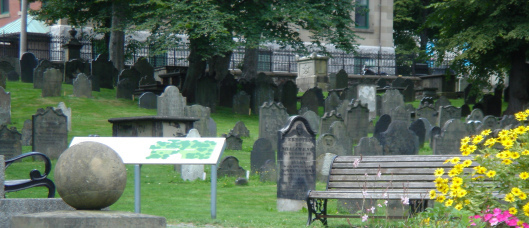
The Old Burying Ground
Anne and Priscilla explore the cemetery, taking turns reading inscriptions on the tombstones. Just as Montgomery found comfort in her walks through Halifax’s Point Pleasant Park when she was homesick for Prince Edward Island, Anne finds comfort when she communes with nature in Old St. John’s: “I don’t know that a graveyard is a very good place to go to get cheered up, but it seems the only get-at-able place where there are trees, and trees I must have. I’ll sit on one of those old slabs and shut my eyes and imagine I’m in the Avonlea woods.”
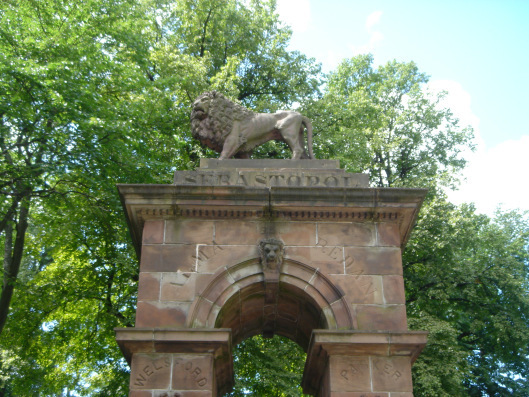
The Welsford-Parker Monument. I decided to dig out some old photos taken in summer, instead of taking more pictures of Halifax in the snow. Yes, it is STILL snowing here…. No signs of spring.
The Welsford-Parker Monument was erected in 1860 as a memorial to Major Augustus Welsford of the 97th Regiment and Captain William Parker of the 77th Regiment, who died at Sebastopol on September 8, 1855. The arch and lion were carved from New Brunswick sandstone by George Laing.
Major-General Robert Ross, who commanded the British troops who set fire to Washington and the president’s mansion in 1814, is buried in the cemetery. Captain James Lawrence of the defeated U.S.S. Chesapeake died in the battle with H.M.S. Shannon in 1813 and was buried here, but was later reburied in Trinity Churchyard, New York. Anne imagines the day the Shannon sailed into “Kingsport Harbor”:
The old graveyard, with its overarching trees and long aisles of shadows, faded from her sight. Instead, she saw the Kingsport Harbor of nearly a century agone. Out of the mist came slowly a great frigate, brilliant with ‘the meteor flag of England.’ Behind her was another, with a still, heroic form, wrapped in his own starry flag, lying on the quarter deck – the gallant Lawrence. Time’s finger had turned back his pages, and that was the Shannon sailing triumphant up the bay with the Chesapeake as her prize.
‘I’ve always loved that old story,’ [Anne] said, ‘and although the English won that victory, I think it was because of the brave, defeated commander I love it.’
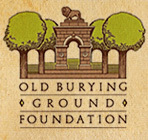 The graveyard closed in 1844, and it was not until the 1980s that restoration work began. A second major restoration has been underway in recent years, and the Old Burying Ground Foundation is grateful for any donations.
The graveyard closed in 1844, and it was not until the 1980s that restoration work began. A second major restoration has been underway in recent years, and the Old Burying Ground Foundation is grateful for any donations.
You can also read more about the Old Burying Ground in “L.M. Montgomery’s Halifax: The Real Life Inspiration for Anne of the Island,” by Sue Lange, in The Shining Scroll, the newsletter for the L.M. Montgomery Literary Society.
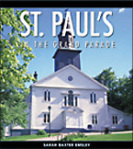 And you can read more about both the Old Burying Ground and St. Paul’s Church in my book St. Paul’s in the Grand Parade.
And you can read more about both the Old Burying Ground and St. Paul’s Church in my book St. Paul’s in the Grand Parade.
If you missed last week’s post on “Anne of Green Gables in Kingsport/Halifax,” you can find it here.


March 27, 2014
Anne of Green Gables in Kingsport/Halifax
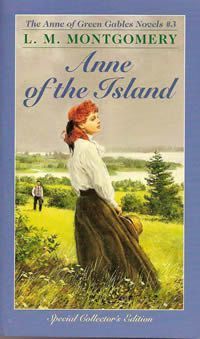 When I read Anne of the Island, the third of L.M. Montgomery’s “Anne” books, as a child, I was living in Halifax. I remember being aware that Montgomery based “Redmond College” on Dalhousie University, and “Kingsport” on Halifax, but I was absorbed in the story and didn’t pay much attention to the landmarks described in the novel. I’ve learned a lot more about Halifax history since then, and I’ve spent a lot of time at Dalhousie, so when I reread the book recently, I found I was even more interested in the setting than in its heroine.
When I read Anne of the Island, the third of L.M. Montgomery’s “Anne” books, as a child, I was living in Halifax. I remember being aware that Montgomery based “Redmond College” on Dalhousie University, and “Kingsport” on Halifax, but I was absorbed in the story and didn’t pay much attention to the landmarks described in the novel. I’ve learned a lot more about Halifax history since then, and I’ve spent a lot of time at Dalhousie, so when I reread the book recently, I found I was even more interested in the setting than in its heroine.
In Chapter Four, when Anne is just beginning to get to know Kingsport, Montgomery gives a snapshot of the town:
Kingsport is a quaint old town, hearking back to early Colonial days, and wrapped in its ancient atmosphere, as some fine old dame in garments fashioned like those of her youth. Here and there it sprouts out into modernity, but at heart it is still unspoiled; it is full of curious relics, and haloed by the romance of many legends of the past.
It has in its park a martello tower, autographed all over by tourists, a dismantled old French fort on the hills beyond the town, and several antiquated cannon in its public squares. It has other historic spots also, which may be hunted out by the curious, and none is more quaint and delightful than Old St. John’s Cemetery at the very core of the town, with streets of quiet, old-time houses on two sides, and busy, bustling, modern thoroughfares on the others.

The Prince of Wales Martello Tower in Point Pleasant Park, built in 1796-97 under the direction of Prince Edward, Duke of Kent.
Montgomery lived in Halifax and took classes in English literature at Dalhousie in 1895-96, and she boarded in a house on Barrington Street. Barrington, a favourite street of mine because I lived there when I was in graduate school in English at Dalhousie, is fictionalized in Anne of the Island as St. John’s Street. Old St. John’s Cemetery is the Old Burying Ground (the cemetery for St. Paul’s Church), and I’ll write more about it soon.
You can also read more about this topic in “L.M. Montgomery’s Halifax: The Real Life Inspiration for Anne of the Island,” by Sue Lange, and “The Dalhousie Girls,” by Christy Woster,” in The Shining Scroll, the newsletter for the L.M. Montgomery Literary Society. The newsletter reproduces some lovely old postcards with views of places in Halifax, including Young Avenue, Point Pleasant Park, the Old Burying Ground, and St. Paul’s Church.

Looking out to sea from the Martello Tower. I took these pictures last Sunday; the park is now covered in snow once again, because of the major storm that started yesterday. Springtime in Nova Scotia!


March 18, 2014
“Reliving the Regency Ball”
You’re invited to an evening at Government House in Halifax on Tuesday, April 1st, to hear Carole and Anne Thompson and members of the Nova Scotia Region of the Jane Austen Society of North America talk about “The Enduring Fascination with Jane Austen and her World.” Their focus is on the customs of a Regency Ball, two hundred years after Austen’s time, and the talk will take place at 7pm in the elegant ballroom at Government House, 1451 Barrington Street in Halifax.
Registration opens today! Call 902-424-7001 or send an email to [email protected] to book your spot at this free, public event.
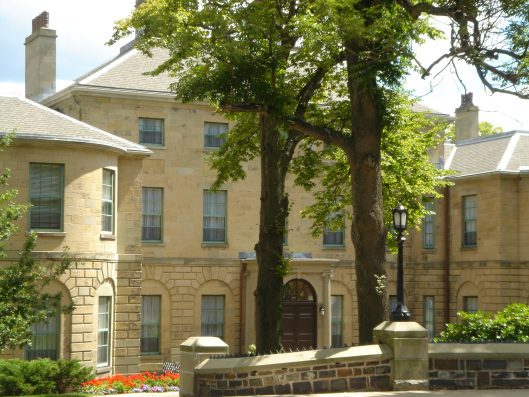
Government House
For more information about this talk and other events in the “Evenings @ Government House” series, click here.
His Honour, Lt.-Gov. J.J. Grant and Her Honour Mrs. Joan Grant invite Nova Scotians, particularly those that have never visited Government House before, to attend a new public event series designed to showcase civic and cultural excellence in Nova Scotia.
This exciting initiative entitled “Evenings @ Government House” will feature diverse presenters and performers from a range of communities across Nova Scotia including musicians, authors, scientists, sporting figures and more. Most events will run from 7:00pm-8:30pm, are free of charge and open to the public.


March 15, 2014
Point Pleasant Park as a Cure for Homesickness
L.M. Montgomery went for a walk in Point Pleasant Park in the early evening of Saturday, March 15, 1902, feeling miserable and lonely, and the pines and the spring air cured her of her terrible homesickness—at least temporarily. She was in Halifax for a year, working as a “newspaper woman” at the Daily Echo, and while there were parts of the job that she enjoyed, she disliked the city (“Halifax is the grimiest city in Canada—I know it is!”) and she missed the countryside around her home in Cavendish, PEI.

Point Pleasant Park on March 14, 2014
She writes of the contrast between the “fine and sunny” day, and her feeling of being “oh, so lonesome! There doesn’t seem to be any connection between the two ideas in that sentence and there isn’t. It just came so. There were hundreds of people in the park and I didn’t know one of them. For awhile I hated life!”
It wasn’t until she left the busy shore road and “fled up into a wilderness of pines and along the Serpentine [path] until at last I found myself alone—and then I was no longer lonesome!” She writes, “It was delicious there. The fresh, chill spring air was faintly charged with the aroma of pine balsam and the sky over me was clear and blue—a great inverted cup of blessing. How glorious it was to see the sky once more, undarkened by rows of grimy houses!”
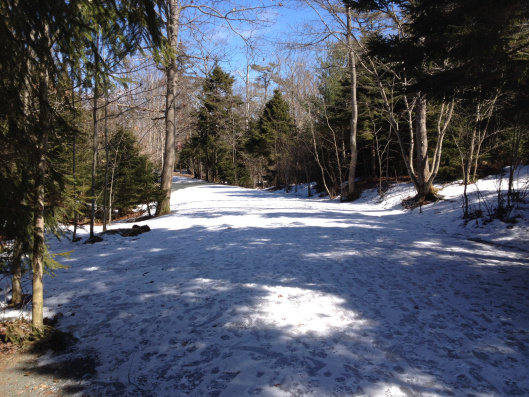
Serpentine Road, March 14, 2014
Pines are her favourite of all trees, Montgomery writes here, and next to them, fir trees. “There is something in these trees—some indefinable charm—that is not found in deciduous trees, beautiful and lovable as these are, too.”
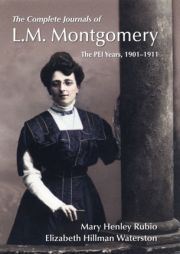
The land at Point Pleasant Park belongs to the British Crown, and the lease is one shilling a year. Many of the trees were destroyed in Hurricane Juan in 2003, but careful management has since revitalized the park and its beautiful forest. The park is one of my favourite places in Halifax — a great place to run, walk, or picnic.
Quotations are from The Complete Journals of L.M. Montgomery: The PEI Years, 1901-1911, ed. Mary Henley Rubio and Elizabeth Hillman Waterston (Oxford University Press, 2013).
Recent posts on L.M. Montgomery:
L.M. Montgomery’s Literary Pilgrimage to Concord, Mass.
L.M. Montgomery at Boston’s Museum of Fine Arts


March 6, 2014
Jane Austen is as Cool as a Cream Cheese
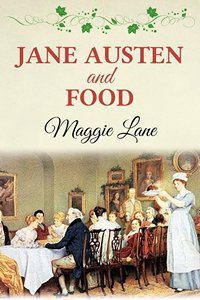 Jane Austen rarely uses similes or metaphors, but when she does, they’re memorable ones. In Jane Austen and Food, Maggie Lane reminds us of one of the most famous lines in Emma – “it darted through her with the speed of an arrow, that Mr Knightley must marry nobody but herself” – and draws our attention to the two food-related similes in Lesley Castle. Charlotte Luttrell describes her sister’s face as “White as a Whipt Syllabub,” and maintains that she herself is “as cool as a Cream-cheese.”
Jane Austen rarely uses similes or metaphors, but when she does, they’re memorable ones. In Jane Austen and Food, Maggie Lane reminds us of one of the most famous lines in Emma – “it darted through her with the speed of an arrow, that Mr Knightley must marry nobody but herself” – and draws our attention to the two food-related similes in Lesley Castle. Charlotte Luttrell describes her sister’s face as “White as a Whipt Syllabub,” and maintains that she herself is “as cool as a Cream-cheese.”
Where else does Austen mention cream cheese? In Mansfield Park, of course: “There, Fanny,” says Mrs. Norris, “you shall carry that parcel for me; take great care of it: do not let it fall; it is a cream cheese, just like the excellent one we had at dinner. Nothing would satisfy that good old Mrs. Whitaker, but my taking one of the cheeses. I stood out as long as I could, till the tears almost came into her eyes, and I knew it was just the sort that my sister would be delighted with. That Mrs. Whitaker is a treasure!”
Jane Austen and Food was first published by The Hambledon Press in 1995 and is now available as an e-book from Endeavour Press. You can read my review of this fascinating book at Austenprose.com:
Is it easier or harder to write if you’re also responsible for feeding and looking after your family? “Composition seems to me impossible, with a head full of joints of mutton and doses of rhubarb,” Jane Austen wrote to her sister Cassandra in September 1816, after a period in which she managed the household at Chawton Cottage in Cassandra’s absence. Fortunately for Jane – and for us, as readers of her fiction – most of the time it was Cassandra who filled this role, freeing Jane to write.
Click here to read the rest of the review.
 And if you ever happen to forget where to find these references to cream cheese, you can always find them again in Maggie Lane’s helpful and entertaining “Index of Food and Drink in Jane Austen’s Fiction.” A few of the other things you’ll find there: apple dumplings, arrowroot, curry, custard, gooseberry tart, pigeon-pie, turnip, and venison pasty. Tea appears more often than coffee, not surprisingly, and wine more often than beer. One of the many charming details Lane discusses is the fact that “the only friendly exchange of a recipe in any of the novels takes place between two men, when Mr Elton jots down (with the bit of pencil which Harriet later spirits away) instructions for making spruce beer given by Mr Knightley.”
And if you ever happen to forget where to find these references to cream cheese, you can always find them again in Maggie Lane’s helpful and entertaining “Index of Food and Drink in Jane Austen’s Fiction.” A few of the other things you’ll find there: apple dumplings, arrowroot, curry, custard, gooseberry tart, pigeon-pie, turnip, and venison pasty. Tea appears more often than coffee, not surprisingly, and wine more often than beer. One of the many charming details Lane discusses is the fact that “the only friendly exchange of a recipe in any of the novels takes place between two men, when Mr Elton jots down (with the bit of pencil which Harriet later spirits away) instructions for making spruce beer given by Mr Knightley.”
If you haven’t yet seen the hilarious reference to cream cheese in the comic strip advertisement from Jane Austen Books, you can see it here, in my interview with Amy Patterson.


February 27, 2014
Milk Fever – a review
“My head and heart informed me that mothering wasn’t contrary to learning, yet instead part of it. I can write and reflect and talk philosophy just as I can suckle a child. No one can tell me . . . that it is not a woman’s privilege to do both,” writes Armande Vivant in a diary entry in 1784 in Lissa M. Cowan’s debut novel, Milk Fever.
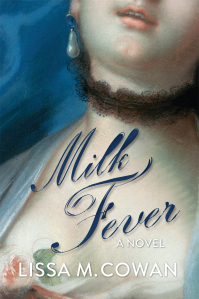
I was intrigued by the premise of Milk Fever, partly because I was reminded of Jane Austen’s famous breastfeeding metaphor (with its echo of the biblical passage from the book of Isaiah). “I can no more forget [Sense and Sensibility], than a mother can forget her sucking child,” Austen wrote to her sister Cassandra when she was reading the proofs for her first novel (25 April 1811). Early in Milk Fever, Armande’s friend Celeste realizes that “books were a kind of food, and that reading was what made Armande’s milk different.” I reviewed the novel for Publishers’ Weekly:
On the eve of the French Revolution, a well-educated wet nurse named Armande Vivant disappears, and the peasant girl she and her father adopted and educated resolves to find her because she believes Armande’s ‘extraordinary’ milk has the power not only to nourish babies, but also to educate and transform the people of France . . . .
Read the rest of the review here.


February 13, 2014
Planning the Mansfield Park Party
 Friday, May 9th is the big day for the launch of my series of guest posts celebrating 200 years of Mansfield Park. I am absolutely delighted that Lyn Bennett is going to kick things off that day by writing about the opening paragraph of the novel. Lyn teaches in the Department of English at Dalhousie University and she’s the author of Women Writing of Divinest Things: Rhetoric and the Poetry of Pembroke, Wroth, and Lanyer (2004).
Friday, May 9th is the big day for the launch of my series of guest posts celebrating 200 years of Mansfield Park. I am absolutely delighted that Lyn Bennett is going to kick things off that day by writing about the opening paragraph of the novel. Lyn teaches in the Department of English at Dalhousie University and she’s the author of Women Writing of Divinest Things: Rhetoric and the Poetry of Pembroke, Wroth, and Lanyer (2004).
And I am very happy to tell you about all the wonderful people who’ve agreed to write for the series. In January I wrote about the first few contributors, and I’ve talked to several people since then. Here’s the full list (so far) of contributors: Elaine Bander, Deborah Barnum, Elizabeth Baxter, John Baxter, Lyn Bennett, Diana Birchall, Lorrie Clark, Jennie Duke, Natasha Duquette, Lynn Festa, Susan Allen Ford, Margaret Horwitz, Syrie James, Theresa Kenney, Ryder Kessler, Hugh Kindred, Sheila Johnson Kindred, Cheryl Kinney, Elisabeth Lenckos, Sara Malton, Juliet McMaster, Robert Miles, David Monaghan, Laurel Ann Nattress, Amy Patterson, Mary C.M. Phillips, Mary Lu Redden, Sarah M. Seltzer, Lynn Shepherd, Julie Strong, Margaret C. Sullivan, Judith Thompson, Deborah Yaffe, Juliette Wells, and Sarah Woodberry.
 Here’s my plan for how things will unfold after Lyn’s first post: we’ll have one post per week until the end of the year, probably on Fridays, with extra posts around the time of Jane Austen’s birthday on December 16th. The posts will run in chronological order, and we’ll cover quite a bit of the novel, but I haven’t made any particular effort to make sure we talk about every single chapter.
Here’s my plan for how things will unfold after Lyn’s first post: we’ll have one post per week until the end of the year, probably on Fridays, with extra posts around the time of Jane Austen’s birthday on December 16th. The posts will run in chronological order, and we’ll cover quite a bit of the novel, but I haven’t made any particular effort to make sure we talk about every single chapter.
I have a question for all of you, readers and guest post contributors: what should we call the series? A party, a celebration, a book club or reading group? My goal is to host a conversation that focuses on what Jane Austen wrote, as a way of honouring Mansfield Park in its anniversary year. Do we need a snazzy title, or should I just call it something straightforward, like “200 Years of Mansfield Park”? Suggestions welcome! I’m calling on your creativity and cleverness to help me out as I organize this party/event/celebration/conversation. Remember what I did last year? “Pride and Prejudice at 200” and “The Custom of the Country at 100.” Informative, yes; dazzling, no. If you leave it with me, I’m sure to come up with a third thing that’s very dull indeed.


February 6, 2014
“The Watsons in Winter”: An Interview with Deborah Yaffe
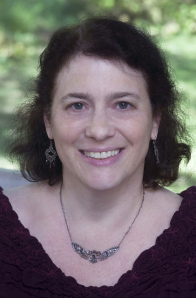 Deborah Yaffe, author of Among the Janeites: A Journey Through the World of Jane Austen Fandom, is writing about “The Watsons in Winter” on her blog, exploring the fragment of the novel Jane Austen began when she was living in Bath, and the continuations and reworkings of the novel written by members of the Austen family and other writers. I’ve been reading her posts and I wanted to know more, so I asked if she’d answer a few questions here.
Deborah Yaffe, author of Among the Janeites: A Journey Through the World of Jane Austen Fandom, is writing about “The Watsons in Winter” on her blog, exploring the fragment of the novel Jane Austen began when she was living in Bath, and the continuations and reworkings of the novel written by members of the Austen family and other writers. I’ve been reading her posts and I wanted to know more, so I asked if she’d answer a few questions here.
Last fall, when I reviewed Among the Janeites, I hadn’t met Deborah, even though we’ve attended many of the same JASNA AGMs, and in fact we still haven’t met in person, though we’ve had email and Twitter conversations over the last few months. I’m very happy to say that she’s writing a guest post for my upcoming series celebrating 200 years of Mansfield Park.
(Deborah’s in great company – if you haven’t seen the line-up of contributors, you can read about some of them here. I’m absolutely delighted that so many clever people have said yes to my invitation. It’s going to be a wonderful conversation among people who enjoy reading Austen’s novels. Please join us when the series starts May 9th! Subscribe to the blog by email and follow me on Twitter @Sarah_Emsley for updates.)
You can read The Watsons at Molland’s, and you can find the introduction and complete list of posts for “The Watsons in Winter” on Deborah’s website.
In Among the Janeites, you focus mainly on contemporary fans of Jane Austen. For “The Watsons in Winter” you’ve gone further back in time: you write that Catherine Hubback’s 1850 novel The Younger Sister is “the first published Austen fan fiction, the founding mother of a genre whose exemplars now fill groaning shelves in bookstores everywhere.” How did you get started on your journey through the world of these earlier Austen fans – what inspired you to research the ten continuations of The Watsons that you talk about in your series?
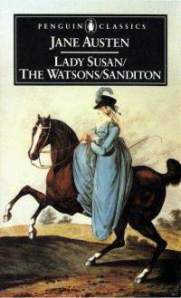 Although I’ve read Austen’s fragments a couple of times, I’ve never known them as well as I know the completed novels. Last spring, when the creators of “The Lizzie Bennet Diaries” announced they were going to follow up with a contemporary web series based on Sanditon, I had a good excuse to go back to that unfinished novel and remember how very good it is. That inspired me to do a blog series on Sanditon continuations, which I called “Sanditon Summer.” (Seaside resort = beach = summer.) I wanted an excuse to re-read The Watsons, too! The bleakness of the book itself, plus the alliterative possibilities of the season, led me to “The Watsons in Winter.”
Although I’ve read Austen’s fragments a couple of times, I’ve never known them as well as I know the completed novels. Last spring, when the creators of “The Lizzie Bennet Diaries” announced they were going to follow up with a contemporary web series based on Sanditon, I had a good excuse to go back to that unfinished novel and remember how very good it is. That inspired me to do a blog series on Sanditon continuations, which I called “Sanditon Summer.” (Seaside resort = beach = summer.) I wanted an excuse to re-read The Watsons, too! The bleakness of the book itself, plus the alliterative possibilities of the season, led me to “The Watsons in Winter.”
There’s a saying that every translation is an interpretation, and I think every fan fiction is also an interpretation; that’s why I’m interested in Austen fan fic. Even when the books are not very good as novels, they may illuminate the many ways in which Austen can be read.
In your first post on The Watsons, you write that “In places, the fragment reads like the first romantic comedy written by Hobbes.” Tell us about the composition of The Watsons, and the speculation by Austen critics about why she abandoned the manuscript.
My understanding – and I hasten to point out that I’m not a literary scholar, just a common reader who loves Austen – is that most critics think The Watsons was written towards the end of Austen’s Bath years, perhaps around 1804. The Bath period doesn’t seem to have been a happy time in Austen’s life, which might account for the wintry quality of her story: it’s about a young woman who has been turned out of the home in which she was raised and, returning to the family she barely knows, finds she’s not really at home there, either.
The Watsons was published for the first time in the second edition of J.E. Austen-Leigh’s 1870 Memoir of his aunt, and Austen-Leigh reports a family tradition about Austen’s plans for the further development of the story. Apparently, things were going to get even worse: Emma’s clergyman father was going to die, and she and her unmarried sisters were going to find themselves dependent on their vulgar and unkind brother and sister-in-law.
The Watsons: Jane Austen’s Fragment Continued and Completed, by John Coates (1958)
And then, in 1805, Jane Austen’s clergyman father died, and she, her mother, and her unmarried sister found themselves dependent on her brothers and their wives. It was the beginning of a very unsettled and difficult time in Austen’s life, which didn’t end until the move to her brother Edward’s cottage at Chawton in 1809. (A move which, biographers have noted, occurred only after the untimely death of Edward’s wife, who does not seem to have been the president of Jane Austen’s fan club.) So critics have speculated that it was too painful for Jane Austen to keep going with a story that so eerily mirrored the circumstances of her own life. It’s a plausible speculation, although – as with so much about Austen’s life and work – we don’t really have solid evidence to confirm it.
One of the passages from The Watsons that I’ve always found memorable is the discussion between Emma Watson and her sister about which fate is worse, marrying someone you don’t like, or becoming a teacher. “Poverty is a great evil; but to a woman of education and feeling it ought not, it cannot be the greatest. I would rather be teacher at a school (and I can think of nothing worse) than marry a man I did not like,” says Emma, and her sister retorts: “I would rather do anything than be teacher at a school…. I have been at school, Emma, and know what a life they lead; you never have.” To what extent do the continuations of The Watsons by other writers pick up on this debate about things that are worse than poverty?
I think that’s a striking passage too. It reminds me of the indelible girls’ school sections in some of the great Victorian novels, like Jane Eyre or Villette or Vanity Fair. (Teacher in an early nineteenth-century school: yet another job I’m glad I didn’t have.) And doesn’t it whet your appetite for the book Jane Austen never finished? Maybe we would have seen a full working-out of this debate between Emma Watson, whose high-mindedness is tinged with naiveté, and her sister Elizabeth, who has led a tougher life and is more realistic about the choices they face. I could see Elizabeth ending up making a Charlotte Lucas-like marriage of convenience, while Emma holds out for something better.
But back to your question. One of the things I found most interesting about the Watsons continuations is the extent to which many of them sidestep the darkness and desperation that seem to me to lie at the heart of Austen’s fragment. Emma Watson has been raised by an aunt and uncle who implicitly promised they would give her a home and a dowry. Then the uncle dies, the aunt remarries, and Emma is out on her ear – no money, no prospects, a burden on her impoverished father and siblings. It’s a harsh reminder of how precarious life in Jane Austen’s world could be for a woman without money, always dependent on the easily revoked kindness of some man or other.
But several of the continuation authors find a way to dispatch the troublesome new uncle, reintroduce the loving aunt, and make Emma an heiress again. And this often happens well before the happy ending. It’s as if these writers can’t really stomach a Jane Austen who isn’t as sunny as the sunniest pages of Pride and Prejudice, so they quickly restore everyone to Happyland. To me, this seems like an evasion of Austen’s theme.
The Watsons, by Merryn Williams (2005)
But of course The Watsons isn’t all doom and gloom – there are some very funny secondary characters and a charming scene in which our heroine rescues a little boy from humiliation by dancing with him at a ball – and fan fic writers are entitled to pick the keynote they find most compelling. This goes to something that I found in researching Among the Janeites: every fan has his/her own vision of what Jane Austen is. My Austen is astringent, ethical, clear-eyed, sometimes ruthless; but many other Janeites see an Austen who is fundamentally kind, comforting, warm-hearted. I don’t think one of these visions is necessarily more correct than the other: it’s a matter of whether you focus more on the rightness of the happy ending or the darkness that lingers around the edges of the story. For me, though, it feels rather incongruous to turn The Watsons, of all books, into a cheery, reassuring tale.
How hard was it to track down copies of the continuations? I know, for example, that you weren’t able to get ahold of Volume III of The Younger Sister – can you give us an update on your efforts to find a digital copy?
I searched Google, Wikipedia, the Republic of Pemberley, WorldCat and Amazon to compile a list of all published Watsons continuations (although, given the speed with which fan fic proliferates, I can’t be absolutely certain I got them all). Once I had the list, it was quite easy to find most of them: three are available in e-book form, two were on the shelves of my local public library, two I got from a university library via interlibrary loan, and two (both self-published) I bought in hard copy online.
The Watsons Revisited: A Continuation of Austen’s The Watsons, by Eucharista Ward (2012)
Catherine Hubback’s The Younger Sister is the frustrating exception, especially since it is, in some ways, the most interesting of the lot – the first published Austen continuation, the work of a close relative, and the basis for two of the other nine Watsons reboots. As I explain in my blog, the first two of Hubback’s three volumes were digitized years ago by the Bodleian Library, and I couldn’t figure out why the third volume was nowhere to be found. (An Amazon offering purporting to be Volume III actually isn’t, according to customer reviews.) Eventually, I emailed the Bod to ask what was up, and they told me their third volume had turned out to be too fragile to scan. Meanwhile, my interlibrary loan request was rejected because the sole loanable copy – in all of the United States! – was checked out and not due back for months. I emailed the library that holds that copy, the University of Iowa, and explained a bit about the historical importance of this book and the missing digital version of Volume III. They responded promptly and very positively, saying they would recall their copy and digitize it; I’m hoping they follow through. (And meanwhile, the grad student who was counting on having it out till June is cursing my name.)
Why do you think some of the writers of these continuations either hide under a pseudonym or hide the degree of their indebtedness to Jane Austen? Edith Hubback Brown is an exception, I know. I laughed when I read the lines you quote from the preface to her novel – “I will not apologise. I like my great-aunt Jane, and she would have liked me” – and your comment on her tone: you say she writes “with an absolute certainty that will sound familiar to other Janeites equally convinced that only an accident of history prevented them from becoming Austen’s closest confidant.” (Even Brown is unclear about who wrote what. As you point out, her husband Francis Brown is credited on the title page as a collaborator, but only Edith Brown signed the dedication and preface.) Why is it so difficult to say, “Jane Austen wrote the first several pages, and I wrote the rest”?
I think only Catherine Hubback hides her indebtedness to Austen: she dedicates her book to her aunt’s memory but never mentions that the original story is Austen’s. But since The Watsons was unpublished at that point, Hubback probably saw no need or reason to advertise the connection. And she had heard the story at her Aunt Cassandra’s knee for years, almost like a fairy tale that you learn by heart. Maybe she felt that Austen’s unfinished work was communal family property. Since Jane Austen in 1850 was nothing like the international phenomenon she’s become in our time, Hubback presumably didn’t see much commercial value in advertising her book’s Austen link.
The later Watsons writers do acknowledge an Austen link – though Hubback’s two descendants tend to underplay their debt to Hubback. (One of these, Hubback’s great-great-nephew-by-marriage, David Hopkinson, is the sole pseudonym-user, as far as I know. I’d speculate that he used a pseudonym because he had published non-fiction under his own name and didn’t want to associate those books with an arguably more frivolous enterprise. But that’s just a guess.) For the people who are writing in the post-Colin-Firth, all-Jane-all-the-time world, it obviously makes strategic sense to go for the Austen market. A couple of the writers do meddle with Austen’s prose, which I think shows more chutzpah than wisdom.
Is “The Watsons in Winter” series part of a larger project?
I don’t anticipate either this series or “Sanditon in Summer” being part of a larger project – they were just fun ways to reacquaint myself with some lesser-known corners of Austen’s work. I’m looking forward to reading Marina Caño Lopez’s work on Watsons continuations when she publishes her St. Andrew’s dissertation (currently not available online, alas).
And I can’t resist asking – are you at all tempted to write your own continuation of The Watsons, or will you leave that to other pens?
Never! I would be far too intimidated to put my minor-league prose and storytelling skills up against Austen’s towering genius. These fan fic writers are much braver than I am.
Do any of you have questions for Deborah about The Watsons, or about Among the Janeites? You can read the first eight posts in “The Watsons in Winter” on her blog, and follow her on Twitter @DeborahYaffe for links to new posts.
If you missed last week’s interview with Amy Patterson of Jane Austen Books (@AustenBooks), you can find it here.


January 31, 2014
Mr. Collins, Mansfield Park, and Jane Austen for Kids: An Interview with Amy Patterson
Amy Patterson runs the fantastic bookstore Jane Austen Books, along with her mother Jennifer Weinbrecht and her sister Beth Dean, and she blogs about Jane Austen at amylpatterson.wordpress.com. She’s writing a guest post on Fanny Price in Portsmouth for my series celebrating 200 years of Mansfield Park. The most recent Jane Austen Books Catalog features Austen-related books for children – and if you’ve been reading my blog recently you know I’m very interested in this topic – so I asked Amy if she’d be willing to answer a few questions about Jane Austen for kids and about her own interest in Austen.
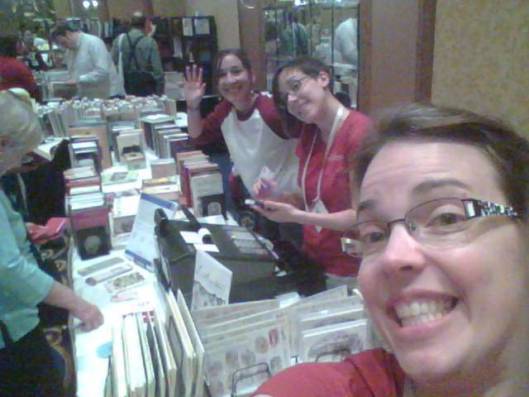
Jane Austen Books at the JASNA 2013 AGM, from left to right: Amy Romero, Beth Dean, and Amy Patterson’s “giant selfie head” (her words, not mine!)
When did you discover Jane Austen’s books? Did you love them right away, or did that develop over time?
 Her books were discovered for me! My mother became a fan in her early teen years, and wanted to pass her love for Austen’s writing on to her daughters. She read us many books when we were young, including most of the classics by authors like Twain, Alcott, and Tolkien. But something about P&P stuck with me when she started reading it to us. I would have been somewhere between four and six years old. She did all of the voices, and she used context and vocal cues to sort of flesh the basic story out of Austen’s complex narrative. I think what stuck the most for me was Elizabeth’s way of speaking up for herself. Even as a young
Her books were discovered for me! My mother became a fan in her early teen years, and wanted to pass her love for Austen’s writing on to her daughters. She read us many books when we were young, including most of the classics by authors like Twain, Alcott, and Tolkien. But something about P&P stuck with me when she started reading it to us. I would have been somewhere between four and six years old. She did all of the voices, and she used context and vocal cues to sort of flesh the basic story out of Austen’s complex narrative. I think what stuck the most for me was Elizabeth’s way of speaking up for herself. Even as a young  child I admired the fact that she was strong, and she became as “cool” for me as Galadriel and Princess Leia. I can’t remember a time in my life that I didn’t love at least P&P, and as I grew up and read the rest of her novels they became favorites as well. She has always been a part of my life, and even as young girls my sister and mother and I shared a special Austen “language.” On our trips to the art museum we would pick out which portraits looked like our favorite characters, and Beth and I vigorously applied ourselves to whatever sonatinas we could get our little fingers on.
child I admired the fact that she was strong, and she became as “cool” for me as Galadriel and Princess Leia. I can’t remember a time in my life that I didn’t love at least P&P, and as I grew up and read the rest of her novels they became favorites as well. She has always been a part of my life, and even as young girls my sister and mother and I shared a special Austen “language.” On our trips to the art museum we would pick out which portraits looked like our favorite characters, and Beth and I vigorously applied ourselves to whatever sonatinas we could get our little fingers on.
Is anyone ever too young to read Jane Austen? What do you think of the many adaptations of Austen novels designed for young readers, including the recent appearance of Austen-inspired board books for babies and toddlers?
I think it’s quite possible for a child to be too young for Austen. We had already had some experience with “chapter books” by the time we had P&P read aloud to us, so we were pretty experienced at listening for the important bits of action and dialogue. Being able to distinguish between background information and important action is a very important skill for children to develop at an early age. And practicing on Austen is (in my opinion) essential, because her cues are so much more subtle than, say, Dickens or Tolkien. You really have to understand what people want – Mrs. Bennet wants her daughters married, Mr. Collins wants a wife, etc. – to be able to pick out the critical moments in the story, because they’re not spelled out in huge battle scenes or violent arguments.
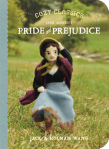 I think the board books are a cute idea for the precocious Austen completist. I don’t know that they should or could replace knowing the full story, but they’re not intended to. In my opinion, they’re valuable for introducing a sense of setting and tone of the novels. The Wang board book [Cozy Classics: Jane Austen's Pride and Prejudice], for example, shows the characters in Regency costume and some of the rooms in Regency décor. And the Adams board book [Little Miss Austen: Pride and Prejudice] conveys some information about the class differences between Darcy and Elizabeth.
I think the board books are a cute idea for the precocious Austen completist. I don’t know that they should or could replace knowing the full story, but they’re not intended to. In my opinion, they’re valuable for introducing a sense of setting and tone of the novels. The Wang board book [Cozy Classics: Jane Austen's Pride and Prejudice], for example, shows the characters in Regency costume and some of the rooms in Regency décor. And the Adams board book [Little Miss Austen: Pride and Prejudice] conveys some information about the class differences between Darcy and Elizabeth.
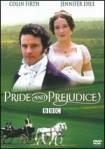 I’m less comfortable with the YA/teen adaptations of her novels, even though most of the ones we’ve come across have been very well done. I suppose I feel that if a child is old enough to understand the words on the page, or at least knows how to look up the ones he doesn’t understand, then there shouldn’t be much of a reason not to read the originals, even if it means supplementing them with watching a film version, or watching the film first. And I don’t think her novels can be “ruined” by the film adaptations, simply because each of them has left out so much that there is still endless treasure to be found in the words on the page.
I’m less comfortable with the YA/teen adaptations of her novels, even though most of the ones we’ve come across have been very well done. I suppose I feel that if a child is old enough to understand the words on the page, or at least knows how to look up the ones he doesn’t understand, then there shouldn’t be much of a reason not to read the originals, even if it means supplementing them with watching a film version, or watching the film first. And I don’t think her novels can be “ruined” by the film adaptations, simply because each of them has left out so much that there is still endless treasure to be found in the words on the page.
My own sons are three and five, and although they answer their toy phones “Jane Austen Books, can I help you?” they don’t yet know more about her than that she was a lady who lived a long time ago and wrote books that mommy loves and grandma has in her house. Colin (my oldest) has had a few Mr. Darcy and Elizabeth stories, but we’re still just getting started with big books. I will probably get them through Roald Dahl before I jump to Jane!
I know the answer to the question, “who’s your favourite Mr. Darcy on film?” (David Rintoul – Amy wrote about the actors who’ve played Darcy in the January/February 2013 issue of Jane Austen’s Regency World Magazine.) But I also know that you’re interested in Mr. Collins and the way Austen describes his upbringing and behaviour in Pride and Prejudice. (See Amy’s blog post “Do You Take this Man? Part II.”) Which of the actors who’ve played Mr. Collins on screen does the best job of getting at his character as Austen wrote it?
I think there have been a lot of near misses for Mr. Collins. But the 1995 Mr. Collins, played by David Bamber, is actually quite a wide miss. He is far too creepy, and is obviously the inspiration for the extremely creepy Mr. Collins in the Lost in Austen series. But the 1980 Mr. Collins goes a little too far the other way – he’s not quite mercenary enough. (Or perhaps his goofy theme song disarms us too much?) I think the 2005 Collins was surprisingly better than I expected, but it’s overall such a poor adaptation that I may have simply been cheering for the one thing that was close to correct.

Mr. Kohli, in Bride and Prejudice
Honestly, I like Mr. Kohli in Bride and Prejudice quite a bit. He’s embarrassingly enthusiastic and just barely pleasant enough to spend the mandatory five minutes with every morning before retiring to one’s rear-facing sitting room. But he’s also repulsively greedy enough, without crossing the line too far into simply personally repulsive, that it’s easy to see why Elizabeth (or in this case Lalita) is so turned off by him.
You were at last year’s JASNA AGM in Minneapolis with Jane Austen Books, celebrating 200 years of Pride and Prejudice. What were some of the highlights of the AGM for you?
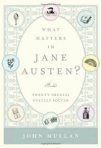 For me, the highlight of the 2013 AGM was John Mullan’s talk on silences in Austen’s novels. As someone who developed a complex vocabulary very early in life, and someone who also has a bit of an OCD nature, I felt like he was inside my head, or perhaps that he had stolen my marked up copy of Emma and read all the crazy things I’ve written in the margins. It was a highlight because it also reinforced the idea that there is always something new to discuss regarding Austen’s books.
For me, the highlight of the 2013 AGM was John Mullan’s talk on silences in Austen’s novels. As someone who developed a complex vocabulary very early in life, and someone who also has a bit of an OCD nature, I felt like he was inside my head, or perhaps that he had stolen my marked up copy of Emma and read all the crazy things I’ve written in the margins. It was a highlight because it also reinforced the idea that there is always something new to discuss regarding Austen’s books.
How are you planning to celebrate 200 years of Mansfield Park in 2014? Will you celebrate with your kids? I haven’t yet seen a Mansfield Park board book – do you know if there are any in the works?
 I will be re-reading MP, which isn’t really a celebration, because I read each novel at least once or twice a year. My boys have already attended a few balls at our local JASNA meetings and at AGMs, and they really enjoy them, so I may take them down to the Jane Austen Festival in Louisville this year.
I will be re-reading MP, which isn’t really a celebration, because I read each novel at least once or twice a year. My boys have already attended a few balls at our local JASNA meetings and at AGMs, and they really enjoy them, so I may take them down to the Jane Austen Festival in Louisville this year.
I have not seen any MP board books, but as it’s (un)fairly unpopular with adult readers I’d imagine children’s authors would start with the more popular titles. We already have P&P and S&S, and I’m betting the next will be Persuasion. After all, nothing is more exciting to kids than a good old-fashioned head injury.
We are also making plans for the 2014 AGM in Montreal. We have already spoken to a customs agent about the border crossing, and my sister is studying the cash register manual so that we can set it up to take two forms of currency. We generally start planning several months ahead of time, but this will be our first time across the border as the owners of Jane Austen Books, and we don’t want to make any mistakes!
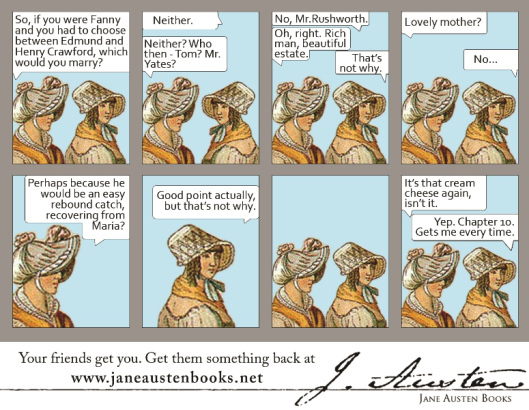
Celebrating Mansfield Park in 2014: Amy says, “Our advertisement in the Jan/Feb issue of Jane Austen’s Regency World Magazine is an MP joke.”
My very first AGM was the 2006 Tucson AGM, before we had the bookstore, and its theme was Mansfield Park as well. To use a cliché, I thought I’d died and gone to heaven! A whole session on Henry’s black heart! As hard as it is to pick a favorite of Austen’s novels, MP is tied with Emma at the very top of my list of books that keep me coming back. There are just so many details, subplots, and esoteric references. It’s not a book you can ever put down and feel as if you’ve seen the whole picture, and that’s incredibly satisfying for those of us who need more than one plot at a time in our novels.
Thanks, Amy! I’m happy to have found one more person who lists Mansfield Park as a favourite, and I’m looking forward to celebrating with you and our JASNA friends in Montreal in October.
Since I first asked you about Mansfield Park board books, I’ve learned from Cozy Classics, via Twitter, that all of Austen’s novels are on their to do list, so someday we’ll be able to read the twelve-word version of MP. I wonder which twelve words they’ll choose….
Do any of you have things you’d like to ask Amy, dear readers? She’s kindly agreed to answer your questions here as well.



